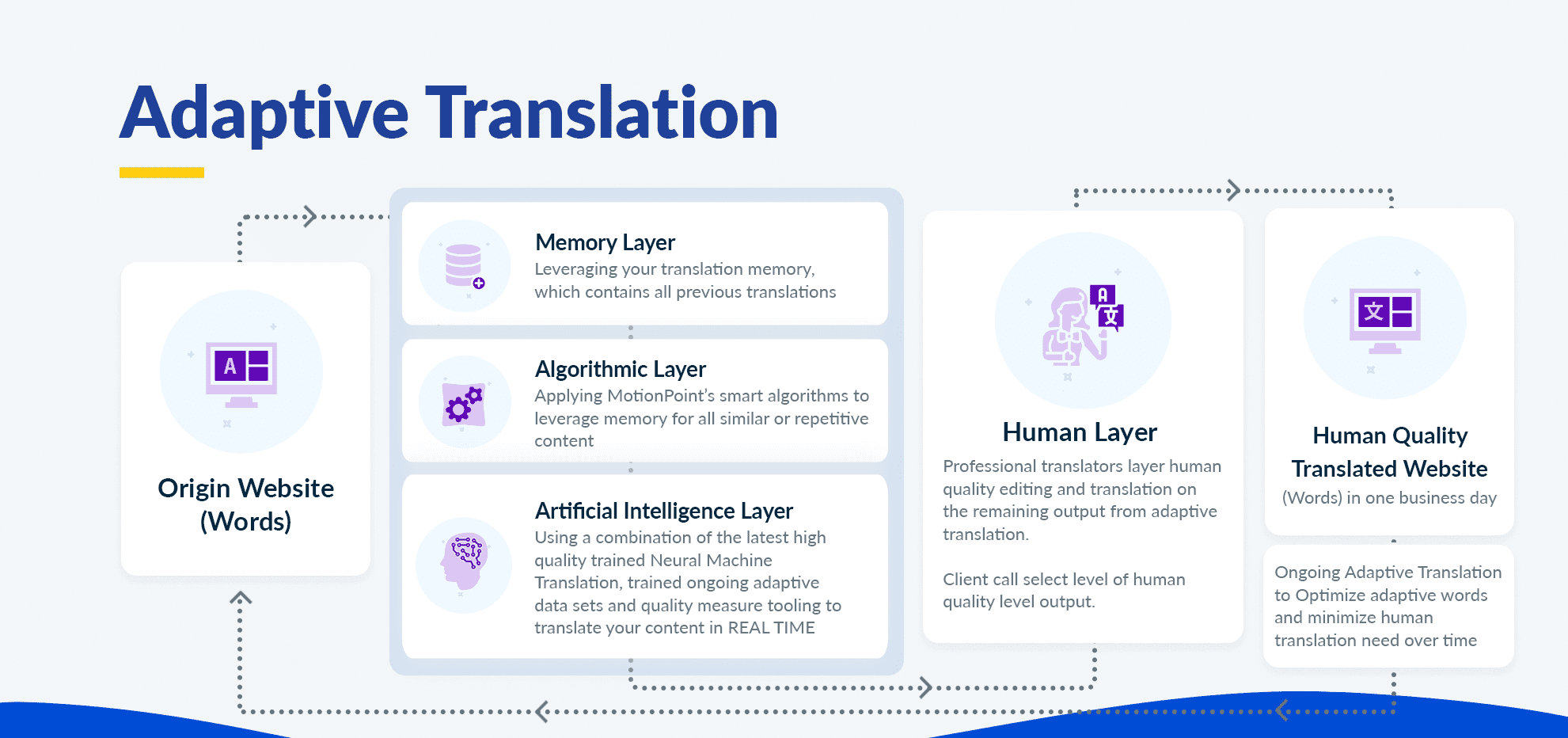The translation quality continuum refers to the spectrum of translation quality, ranging from low-quality translations that may be inaccurate, confusing or contain errors, to high-quality translations that accurately convey the meaning and intent of the original text. Translation quality is better thought of as a continuum, as it allows us to align with the idea that a company's intrinsic interest is to invest only when necessary and not all the time.
Currently, translation quality is thought of as human=good and machine=bad, and that's not necessarily true. The next wave of innovation in the translation industry is using quality estimation and quality evaluation to better understand what translations need MTPE (Machine Translation Post Edit) and which are good enough as they are.
The reason thinking is upside down is likely because the translation industry has focused on selling human translation quality, which is more profitable than machine translation. But as machine translation tolerance is getting higher and higher, things are set to change. The translation quality continuum is a useful framework for understanding the various levels of translation quality and the factors that influence them.
What Does the Spectrum Look Like?
At one end of the continuum are machine translations, which are produced by computer algorithms without human intervention. Certain machine translation tools ALONE are generally considered to be of low quality as they often lack the nuance and context needed for accurate translation. An example of this is Google Translate, which may work well enough for basic content, but likely won't produce high enough quality especially when it comes to specialized (domain specific) content or branded content. It's important to note that this changes when you combine machine and human translation, but we'll get to that later.
At the other end of the continuum are professional human translations, which are produced by trained translators who are fluent in both the source and target languages. Professional human translations are generally considered to be of high quality as they can accurately convey the meaning and intent of the original text while accounting for cultural and linguistic nuances. However, this method can become very expensive very quickly and is not very efficient.
In the middle is a combination of translations that may have different needs and sensitivities to translation quality. Of course, there are many levels of translation quality that fall between these two extremes. For example, there are translations produced by non-professional translators, such as bilingual individuals or amateur translators, which may be of varying quality depending on the translator's skills and expertise.
What Impacts Translation Quality?
Translation quality is influenced by many factors, including the translator's proficiency in the source and target languages, their knowledge of the subject matter, their understanding of the cultural context, and the available resources and time constraints. Each of these factors can affect the accuracy, fluency, and overall quality of the translation.
In terms of machine translation (MT), the quality of the output depends on very different factors.
Domain-Specific Vocabulary
Machine translation systems may struggle with translating domain-specific vocabulary that is not commonly used in everyday language. For example, technical terms in the medical or legal field may require specialized translation knowledge and may not be accurately translated by a general-purpose MT system.
Context
Context is an important factor in determining the meaning of a sentence or phrase. MT systems may struggle with understanding the context of a sentence, especially when dealing with idiomatic expressions or other nuanced language use.
Quality of the Input Text
The quality of the input text can have a significant impact on MT quality. Errors or inconsistencies in the source text can result in mistranslations or other errors in the output text. Additionally, the formatting of the input text, such as punctuation and capitalization, can also impact the quality of the translation.
Training Data
Machine translation systems rely on large amounts of training data to learn how to translate effectively. The quality and quantity of training data can impact the performance of an MT system. Limited training data or training data that does not adequately represent the target domain may result in lower quality translations.
What to Look for When Evaluating Quality
1. Accuracy and completeness
The most fundamental measure of translation quality is accuracy, which refers to how well the translated text reflects the meaning and intent of the original text. Accuracy is often evaluated by comparing the original text to the translated text and identifying any errors, omissions, or mistranslations. This process is known as a quality assessment or a quality assurance review. The completeness of the translation is also important, meaning that all the relevant information from the original text is conveyed in the translated version.
2. Fluency and readability
Fluency refers to how natural and smooth the translated text reads. It encompasses the use of appropriate grammar, syntax, and vocabulary in the target language. Readability, on the other hand, measures how easily the translated text can be understood by the intended audience. These factors can be evaluated by having native speakers of the target language review the translation and provide feedback.
3. Cultural appropriateness
Translators must take into account cultural differences and norms when translating a text, especially when it comes to idiomatic expressions or cultural references. Evaluating the cultural appropriateness of a translation requires a deep understanding of the cultural context of both the source and target languages. Professional localization experts may need to assist and evaluate the translation for cultural appropriateness.
Learn about the importance of the website localization
4. Consistency
Consistency in translation refers to the uniform use of language, terminology, and style throughout the translated text. This is particularly important for technical or specialized translations, where consistency in terminology is crucial. Consistency can be evaluated by comparing different sections of the translated text to ensure that the language, terminology, and style are consistent.
What Tools Are Used to Measure Translation Quality?
Human Reviewers
One of the most common ways to measure translation quality is by having human reviewers read the translated text and evaluate its accuracy, fluency, cultural appropriateness, consistency, and readability. Human reviewers can include subject matter experts, language professionals, or bilingual speakers with knowledge of both the source and target languages.
Translation Memory Tools
Translation memory (TM) tools are software programs that store previously translated text segments, allowing translators to reuse them in future translations. TM tools can also help maintain consistency in terminology and style, which can improve translation quality. By analyzing the translated text against the stored segments, TM tools can identify errors, omissions, or mistranslations.
Make sure your translation memory is being updated and deployed properly. If not, your translation quality could be suffering. If you want to know if your language service provider is handling your TM effectively, let us give you a free assessment! We’ll even help you switch to MotionPoint by covering any discrepancies you may face.
Machine Translation Evaluation Metrics
Machine translation (MT) evaluation metrics are software programs that use automated metrics to evaluate the quality of machine-translated text. These tools can evaluate the accuracy, fluency, and readability of the translation, as well as its consistency with the source text. Here are a few examples:
1. BLEU
BLEU (Bilingual Evaluation Understudy) is a metric that measures the similarity between a machine-translated text and a reference translation. It evaluates the quality of the translation based on the number of overlapping n-grams (continuous sequences of words) between the machine-translated text and the reference translation. BLEU is a widely used metric and is often used to evaluate the performance of MT systems in research and development.
2. TER
TER (Translation Error Rate) is another metric used to evaluate the quality of machine-translated text. TER measures the difference between the machine-translated text and the reference translation in terms of the number of edit operations required to transform the machine-translated text into the reference translation. The edit operations include substitution, deletion, and insertion of words, and the TER score is calculated based on the number of edit operations required per word in the machine-translated text.
3. METEOR
METEOR (Metric for Evaluation of Translation with Explicit Ordering) is a metric that takes into account both the fluency and adequacy of the machine-translated text. It evaluates the quality of the translation based on a combination of unigram precision (the number of words in the machine-translated text that match the reference translation), recall (the number of words in the reference translation that match the machine-translated text), and alignment between the two texts.
Each of these metrics has its own strengths and weaknesses, and the choice of metric depends on the specific needs and requirements of the translation project. Overall, MT evaluation tools are useful in providing an objective measure of the quality of machine-translated text.
Adaptive Translation™: Maximizing Translation Quality
At MotionPoint, we know that the way to get the best quality translations at the lowest possible cost is to use a mix of machine and human translation methods. Our new Adaptive Translation™ technology combines the best of machine translation, translation memory, and algorithms with an optional human layer of review to catch any inaccuracies and ensure the most comprehensive output
Here’s an overview of how Adaptive works to reduce human intervention while constantly improving translation quality:

Prioritizing Translation Quality
In today's global marketplace, having a website that is accessible and easily understandable to your audience is essential to expand reach and increase customer base. However, it is not enough to simply translate a website into another language - the translation quality must be high to ensure that the website is effective in communicating its message to its intended audience.
You need to work with a concierge-level translation partner that knows how to provide the best quality translations without breaking your bank. Reach out to us today to get started, and learn even more by downloading our recent webinar on website translation in light of AI. You can find it here.
Last updated on May 22, 2023